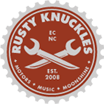 |
| Modern day system disruptor and the real life Tony Stark, Elon Musk doesn't understand the word, no. |
We tend to think that if you challenge the norm and push forward with new ideas, you will be rewarded for the long haul. It may not be monetarily, or it might not happen for quite a few years, but putting skin in the game is the key to survival. I was told once that if you can last 10 years in the punk rock game, then you will have a name for yourself. This is partially true and holds the most weight by simply sticking to your guns. It takes more than just time to achieve solid results, you also need to add know how to your never adding stack of tools.
There was a cool article that just popped into our inbox from an email blast about a write up in the Huffington Post about push and pull marketing. Never heard of this jargon? Well, surely you have experienced it and not ever known what was going on. Read the article below and think on new ways to capitalize on opportunity. The content creators will always rise above.
Check out original article over at HuffingtonPost.com
"A common argument in the digital music era involves whether the Internet has empowered artists to control their own destiny. Now more than ever, there are incredible opportunities for artists to distribute their original work directly to their fans, with the goal of acquiring new fans and taking their act global. However, piracy has made it difficult for artists to sell their music, and the vast sea of young and buzzed-about artists has made it even harder to break through the noise so live performances are more important than ever for artists to make a living.
So how do musicians reach audiences, and where are they? Long gone are the days when music fans would pick up a copy of Time Out or City Guide to see who is playing near them that weekend. We know fans are shifting to online services like Spotify and Pandora to stream and listen to music, but the main question is how to engage them and alert them when artists are on tour?
To begin, it's essential to understand the two basic forms of music marketing: Push Marketing and Pull Marketing.
- Push marketing requires you to create demand by actively distributing your music and events. Push marketing helps musicians both new and established rise above the fray, whether for recorded music or for tour dates.
- Pull marketing effectively pulls fans to your website or band page who may already be looking for new music and hoping to "discover" you. Pull takes advantage of pre-existing market demand.
It's important to note that what we call music "discovery" is actually a passive activity for consumers. Streaming music sites like iHeartRadio and Songza are great examples of this, since listeners simply click on a station and let the service do the rest -- providing hours of endless curated entertainment. The same way the discovery of recorded music is a passive activity, so too is the discovery of live events.
In the fall of 2012, Bandsintown commissioned a study of American concertgoers to better understand what brings people out to shows and how to reach them. The results determined that music fans prefer to receive "push" notifications, such as Facebook posts and email blasts about upcoming shows, rather than "pull" notifications from artist or event websites. More than 80 percent of music fans surveyed said that Facebook posts and email blasts inspire them to purchase concert tickets, compared to more traditional outlets like magazines, newspapers, or even blogs. The survey also found that the majority of all fans buy concert tickets in advance when notified -- about 75 percent of the time -- because they don't want to risk missing the show. That's guaranteed revenue since artist's most dedicated fans have paid up front, and there are still countless artists in and out of the mainstream that are ignoring this tactic.
Musicians typically believe that because push marketing requires an investment of their time it will get in the way of what they love most -- make great music. It's true that with today's virtually unlimited choice of music, interacting with fans is now a part of the job if you want to be successful. However, there are inexpensive online tools available -- from Mobile Roadie and Bandsintown to Sonic Notify -- that effectively utilize social networks and automate the push marketing process, freeing up valuable time for other important things.
So while there has been a hazy cloud hanging over artists, managers and labels relating to how digital music and the Internet affect their sales and bottom lines, the opportunity provided by push marketing remains an untapped well for a wide swath of artists, from no-name garage bands to arena headliners. The bands are there, the fans are there, and the technology is there -- it's time that the dots are connected in a way that ensures success and exposure for artists of all stripes, while ensuring that fans are more plugged in and aware than they've ever been before."






























